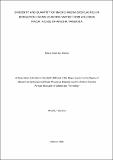Diversity and quantity of macro-and microplastics in irrigation farms sourcing water from an urban river: a case of Arusha Tanzania
Abstract
Increased concentration of plastics in urban rivers and agricultural farms causes degradation
of river system functionality and reduces the productivity of agricultural soils, respectively.
This study assessed the quantity and types of macro-and microplastics found in dependent
smallholder irrigation farms downstream of Arusha city in Tanzania. The microplastics'
concentration from the sites was visualized using dissecting microscope 40X, enumerated and
categorized based on the shape, color, and sizes for soil samples. Then the suspected materials’
spectral were determined using the Attenuated Total Reflectance- Fourier Transform Infrared
(ATR-FTIR). Afterwards, the confirmations and identifications of the polymers' types from
spectral were confirmed using SiMPle Software. The average microplastic from the water
column was 0.57 ± 0.27 items L-1
, sediment 0.17± 0.07 items g-1, while in the irrigation farms
ranged from 102 to 728 items with a mean of 0.69 ± 0.35 items g-1
. However, no international
standards have been developed to ascertain the pollution level, but the reported values are
unsafe to the environment. Other studies conducted in similar conditions reported mean values
within the range of values found in this study and more. Polyethylene was the dominating type
of macroplastics evaluated from riverbanks and irrigation farms with a frequency of occurrence
100 %, while polystyrene was abundant in all microplastics samples. Farms adjacent to the
irrigation canal had a greater number of microplastics and macroplastics. Thus this study
reveals urban rivers as the primary sources of plastics pollution in the irrigation farms situated
in flood-prone zones.

